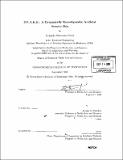S.N.A.K.E. : a dynamically reconfigurable Artificial Sensate Skin
Author(s)
Barroeta Pérez, Gerardo
DownloadFull printable version (50.49Mb)
Alternative title
Dynamically reconfigurable Artificial Sensate Skin
Other Contributors
Massachusetts Institute of Technology. Dept. of Architecture. Program In Media Arts and Sciences
Advisor
Joseph A. Paradiso.
Terms of use
Metadata
Show full item recordAbstract
The idea of an Artificial Sensate Skin device that mimics the characteristics and functions of its analogous living tissue whether human or animal is not new. Yet, most of the current related work has been focused in the development of either materials, flexible electronics or ultra-dense sensing matrices and Wide Area Sensor Networks. The current work describes the design and implementation of a new type of Artificial Sensate Skin. This Artificial Sensate Skin is implemented as a low-power, highly scalable and mechanically flexible Wired Sensor Network. This Skin is composed of one or many Skin Patches which in turn are composed of one or many Skin Nodes. Each node is able to measure Strain, Pressure, Ambient Light, Pressure, Sound and Mechanoreception. Each Skin Patch can either work as a stand-alone device or as a data extraction device if this is attached to a Personal Computer through a different type of device referred to as Brains. Each Skin Node and therefore each Skin Patch :is Dynamically Adaptable meaning that they can adapt to external stimuli by either modifying their behavior or by completely changing their code. (cont.) Construction of a sensate skin in such a modular fashion promises intrinsic scalability, where peer-to-peer connections between neighbors can reduce local data, which can then be sent to the brain by the high-speed common backbone. The current project also involves the design and implementation of the software components needed; these include a PC Graphical User Interface, application software and the firmware required by the embedded microcontrollers. Results show that needed resources like bandwidth are greatly minimized because of the addition of embedded processing power. Results also indicate that the platform can be used as a scalable smart material to cover interactive surfaces, or simply to extract a rich set of dense multi-modal sensor data.
Description
Thesis (S.M.)--Massachusetts Institute of Technology, School of Architecture and Planning, Program in Media Arts and Sciences, 2006. Includes bibliographical references (p. 207-211).
Date issued
2006Department
Program in Media Arts and Sciences (Massachusetts Institute of Technology)Publisher
Massachusetts Institute of Technology
Keywords
Architecture. Program In Media Arts and Sciences